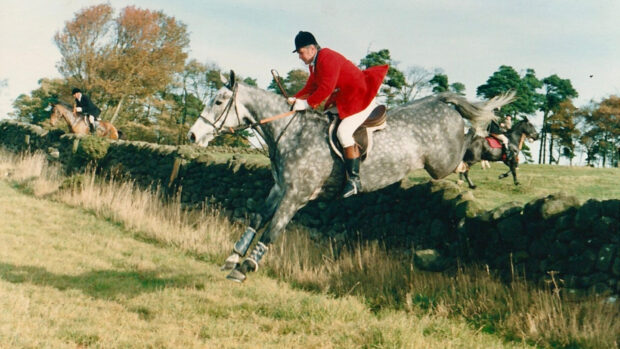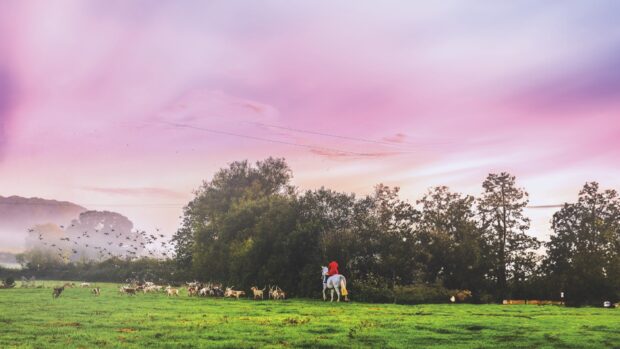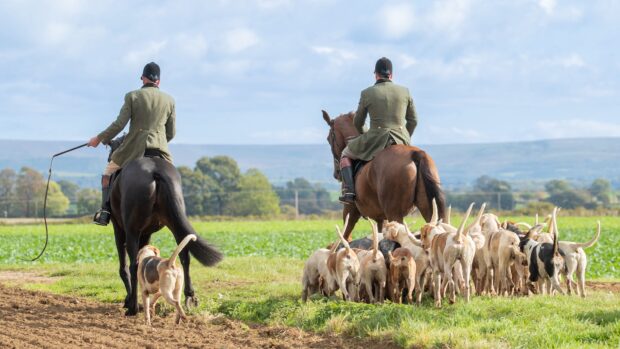Followers of the Fernie were treated to a uncommon sight this week when rare breed enthusiast Bruce Langley McKim debuted his Suffolk horse on the hunting field.
Imposing nine-year-old Craikhowhall Jensen has been a working stallion for most of his life but was only recently introduced to a ridden career.
“He was lunged on a Tuesday, sat on on a Wednesday and ridden on the Thursday — he then blew the stable door clean off its hinges so he went to stud for the summer and came back once we’d got a heavy duty box!” said Bruce, who bought the horse last year. “He’s been back in work two-and-a-half months and we’ve been working on getting him fit.”
The meet at Illston was not only the stallion’s first appearance hunting but also his first time ridden in public.
https://www.facebook.com/groups/thegreatbritishsuffolkpunch/permalink/1444169395694016/
“It was a small meet and I know the country like back of my hand so I thought I’d do a circuit around the farm and when they go cross-country, I could hilltop from there. I took him out for an hour and he stood with the hounds as good as gold,” Bruce said. “He’ll be out again for a couple more days and then he’s been selected by Suffolk Punch Trust to go to Twemlows for [semen] collection.”
Suffolks were bred to plough but as mechanisation took over, their numbers have dwindled to between 300 and 400, making them the most critically endangered British equine species.
“I like to do something different and my aim was to take a rare breed and make it more commercial,” said Bruce, who believes Suffolks have a marketable future in cross-breeding.
“I always say that for every part-bred there needs to be a pure-bred,” he added. “[Making a useful cross for hunting] gives the horse another string to its bow. There is a place for half-breds because people want big horses and you don’t get a true heavyweight very often nowadays, even in Ireland.”
Bruce said Jensen — whom he describes as “kind as a Christian” and “as easy as pie to break” — had proved a comfortable ride.
“He’s not actually that wide. We’ve had him on the walker getting him fit, so there is not too much bulk and you’re not sitting on bulbous weight. He wouldn’t feel that much different to a decent sized cob. I’m also lucky with him as he’s quite athletic and he can make a shape over a fence,” he said.
“What I am doing with him isn’t what they were designed for but that job doesn’t exist any more. I’m not looking to change the breed but I think they have to diversify.”
Jensen is one of four stallions standing at the Thorpeley Stud, all of whom also have regular jobs hunting as well as making appearances showing and team chasing.
Continues below…

Adorable Suffolk foals help to promote breed
The Suffolk horse is rarer than the giant panda with the number of breeding mares left in the UK estimated

Suffolk Punch foal returns home with her foster mum
A Suffolk Punch foal who had to be fostered has returned home with her new mum and is reported to

Queen breeds endangered Suffolk horse
The Queen's Suffolk Horse Whitton Poppy gives birth to a colt, adding to the numbers of the endangered native breed.
Bruce also stands two Irish draughts — Carrigfada Diamond and Carrigfada Grey Mist — and the Irish draught sport horse Cos Me Is Black. The latter stallion has featured as one of H&H’s Hunt Heroes and became the first stallion ever to complete the Melton ride, as well as competing and hunting side-saddle.
“All my boys have to have a life and have to do something,” explained Bruce.
“You don’t see many stallions out hunting — while you don’t want to risk them, I don’t go showboating. You take a calculated risk taking them out but I don’t want to keep them penned up not seeing the light of day. They jump, they’re bold and they do what they say on the label because of the life they have.”
Bruce was also keen to dispel a myth about why you don’t see many stallions in the field.
“People also say that stallions don’t like to jump the big hedges because they’re careful of their bollocks but that’s just an excuse.” he added “They don’t swing in the wind!”
For all the latest news analysis, competition reports, interviews, features and much more, don’t miss Horse & Hound magazine, on sale every Thursday.




